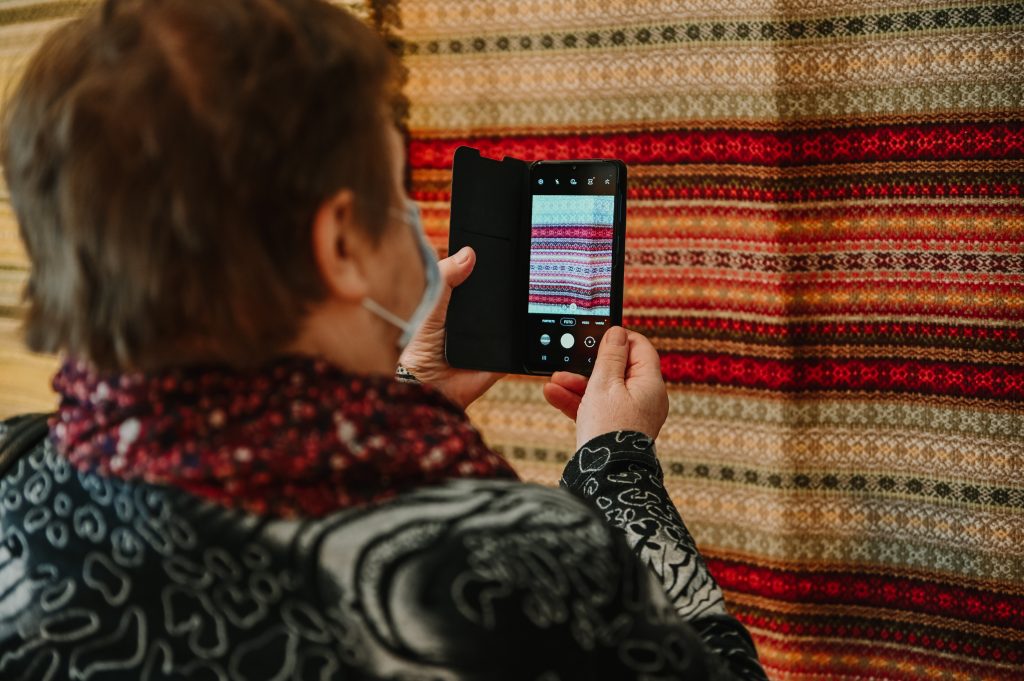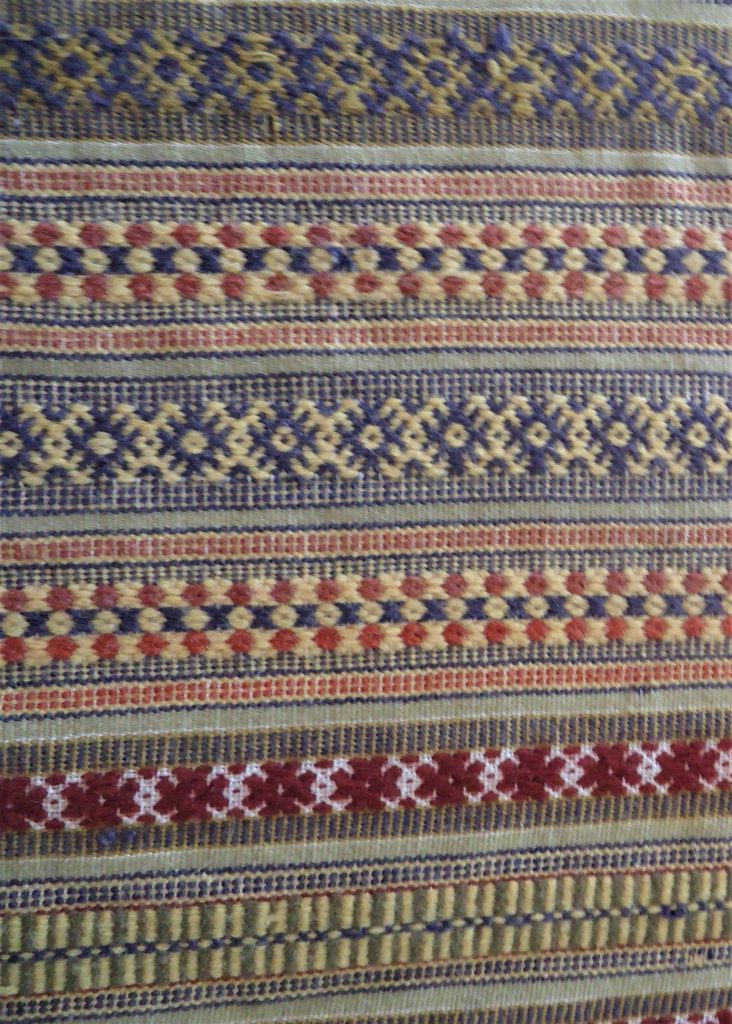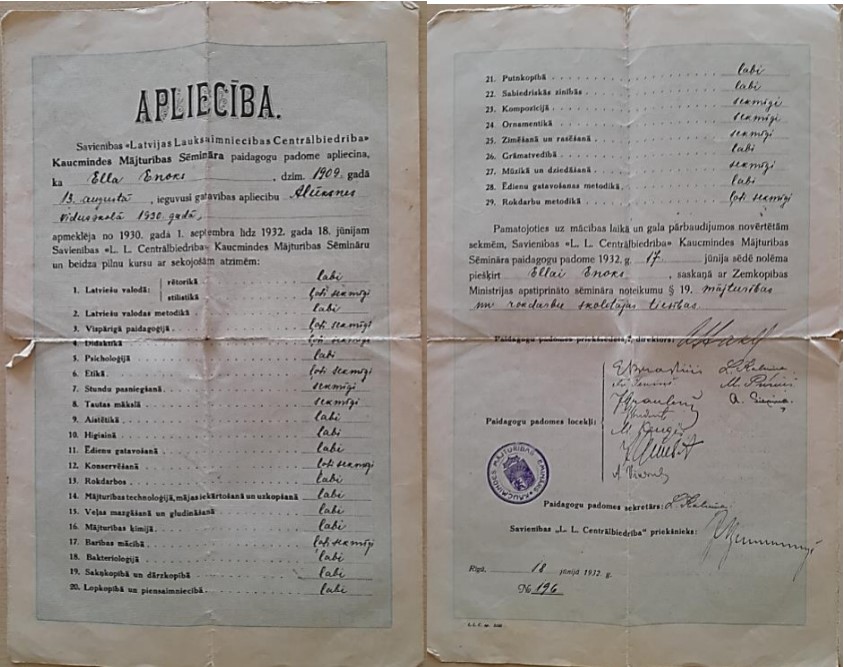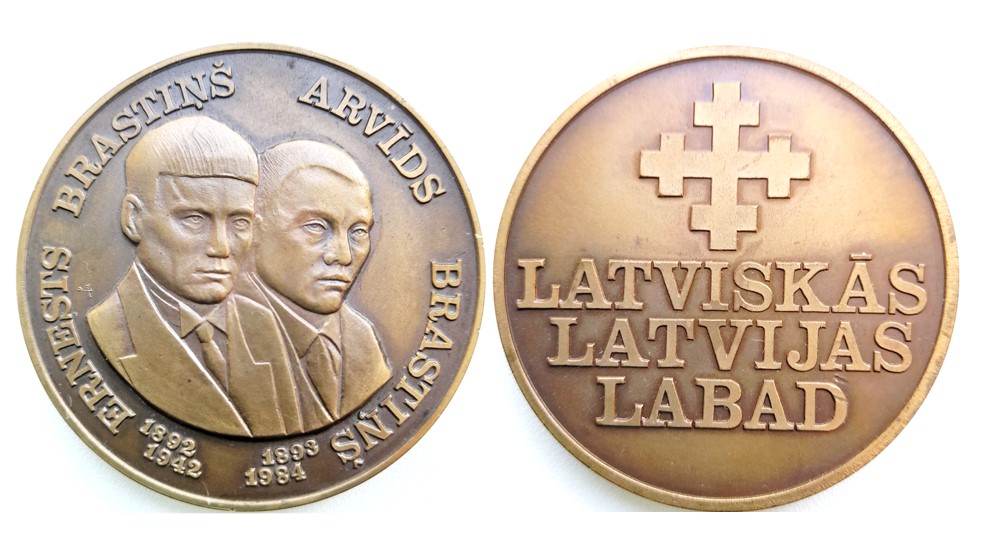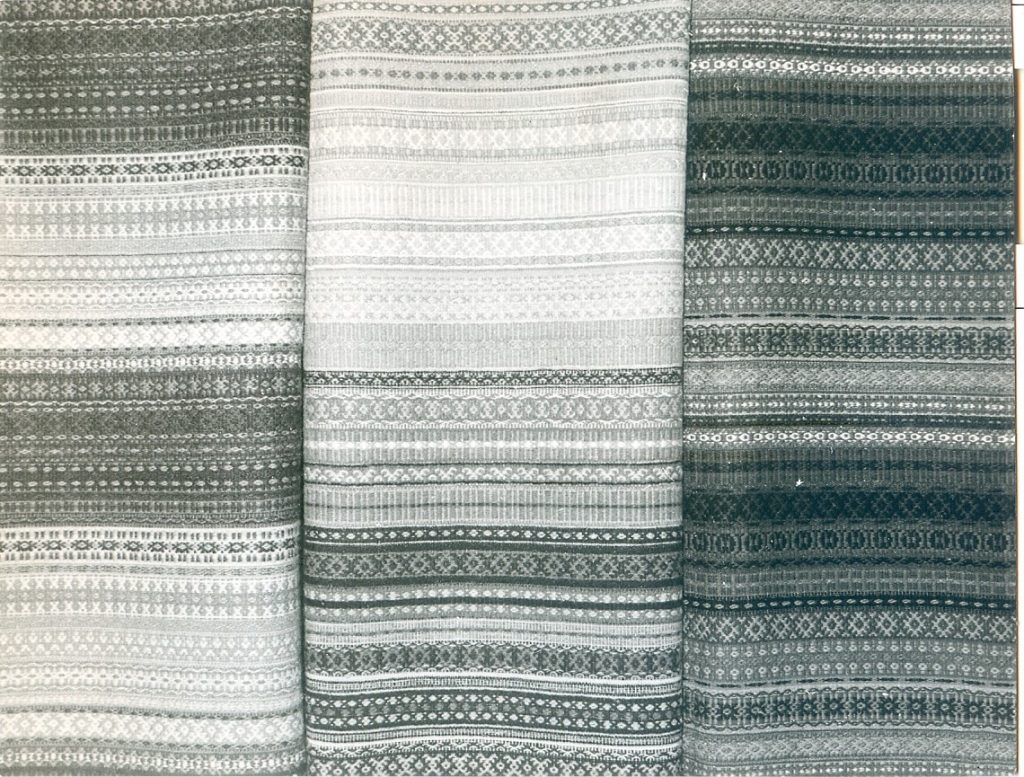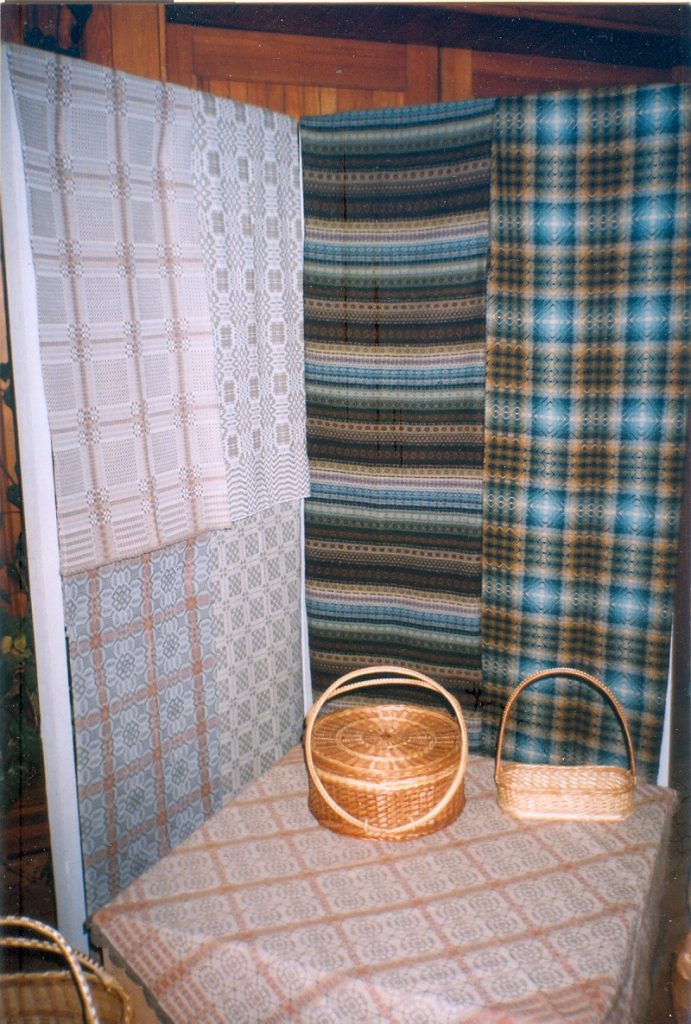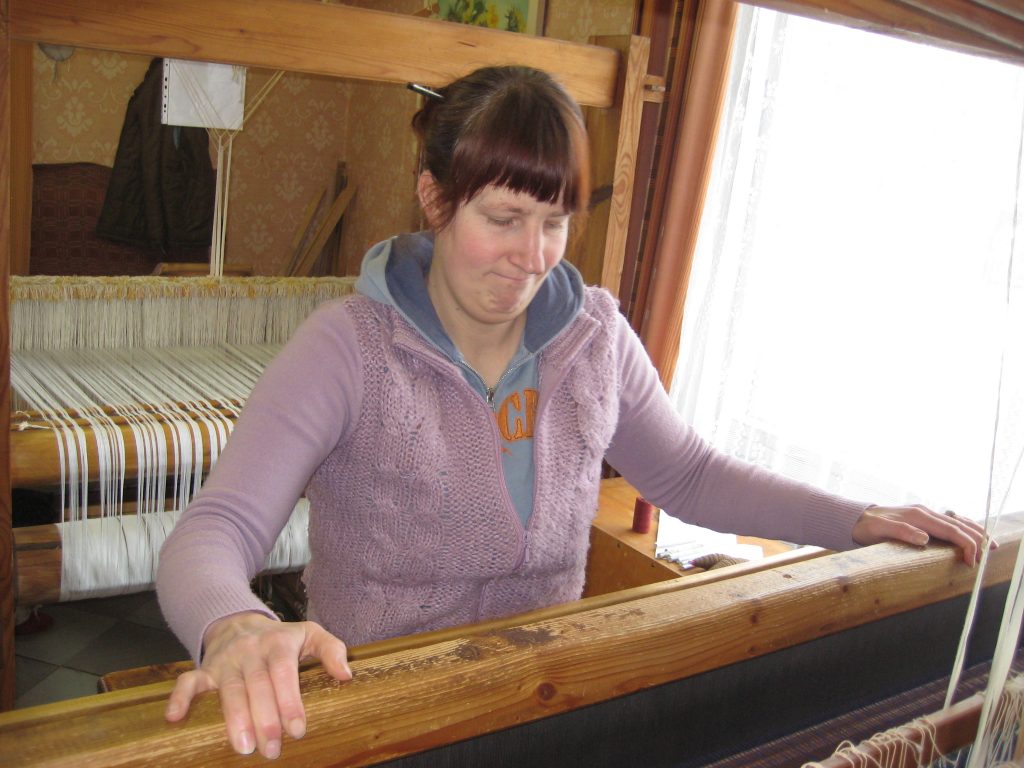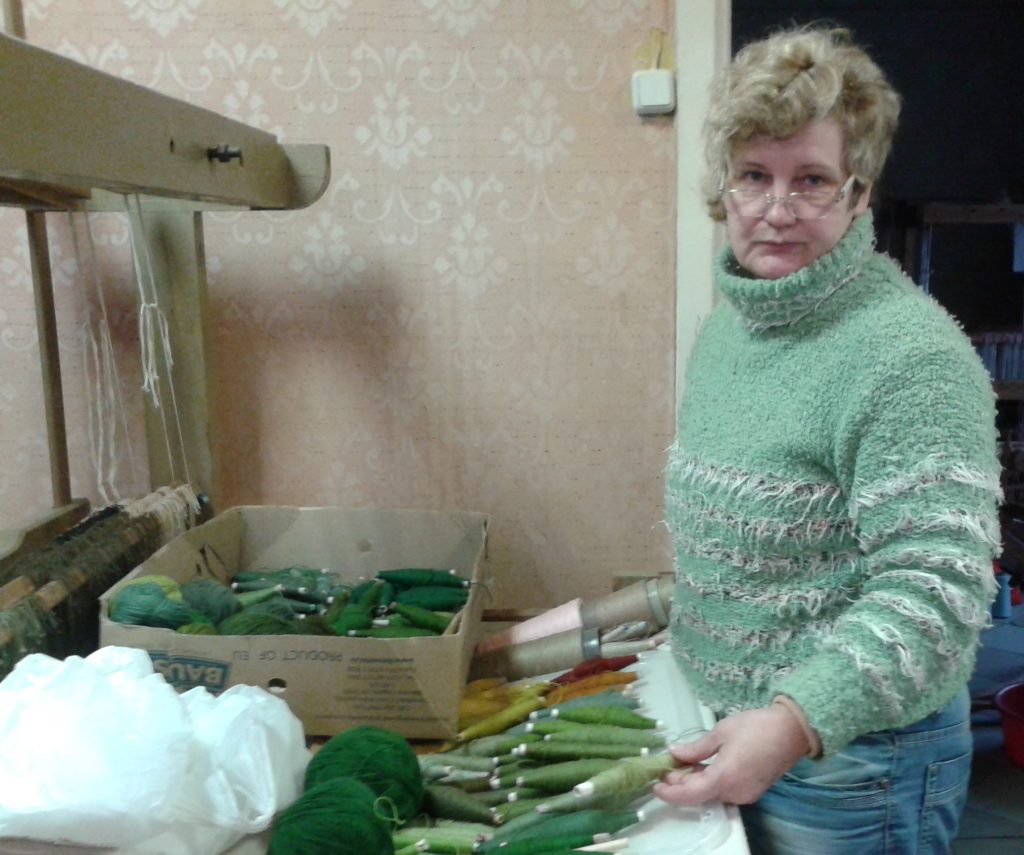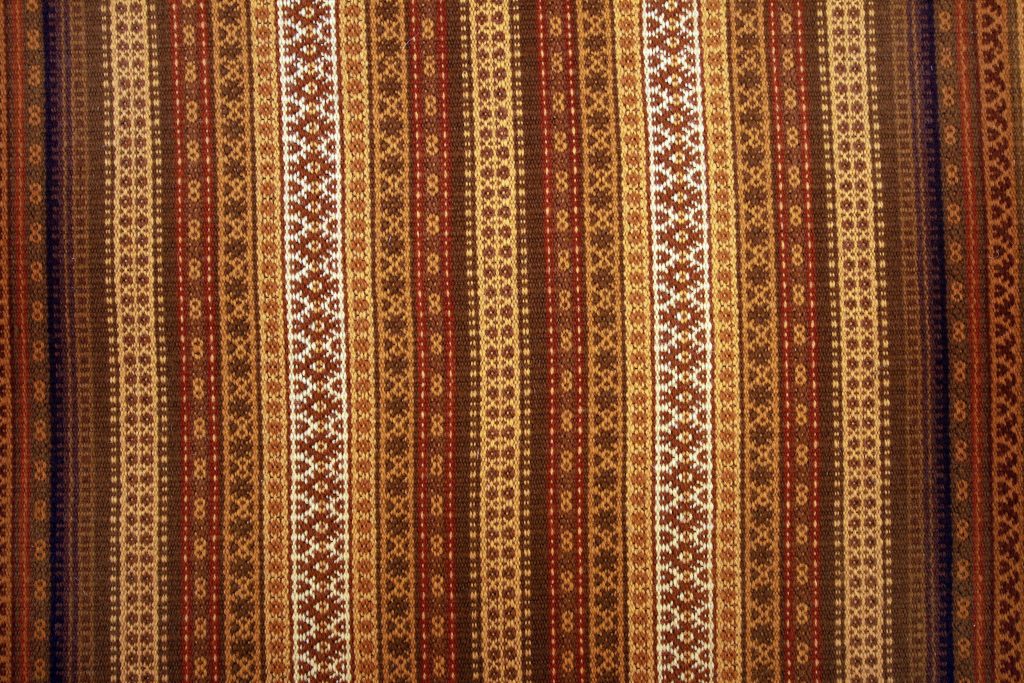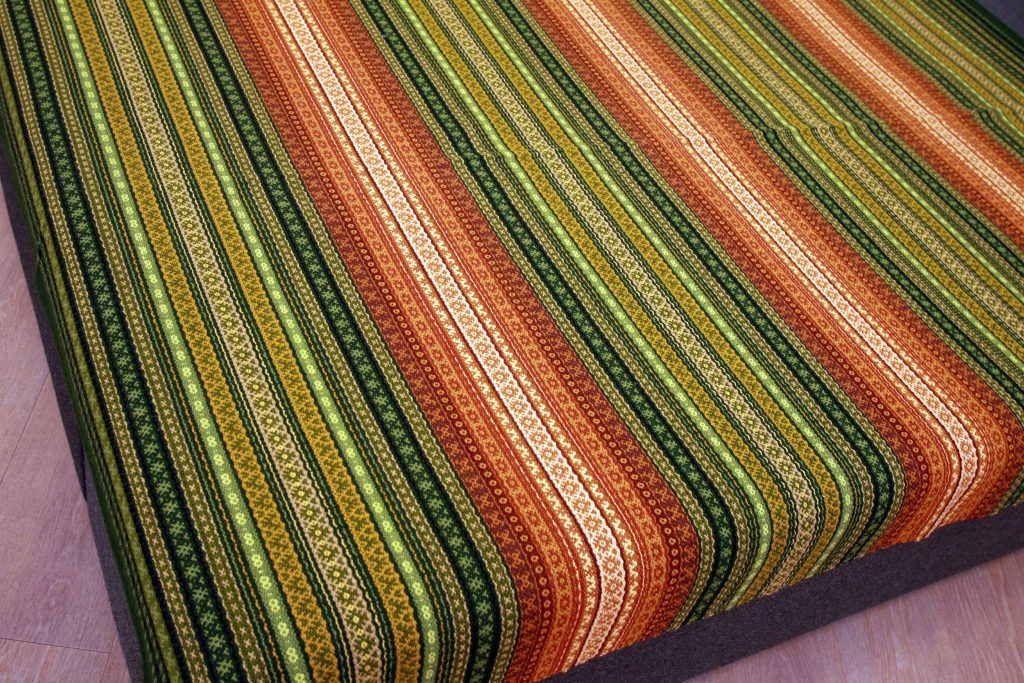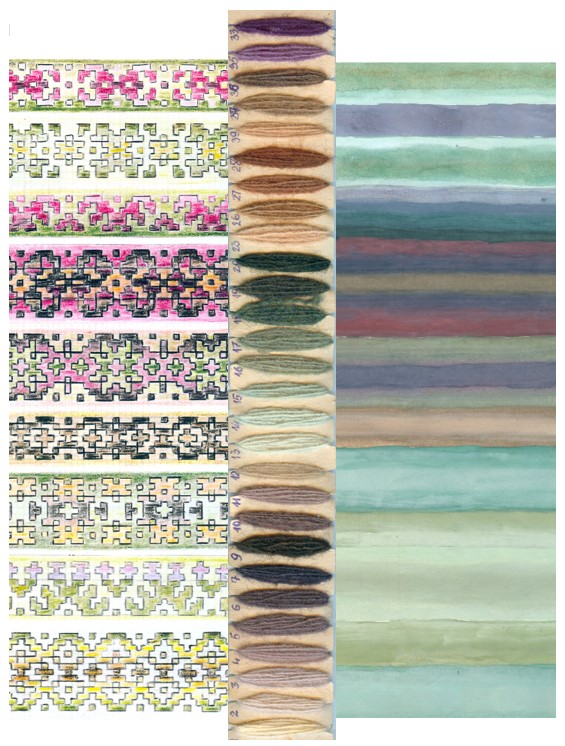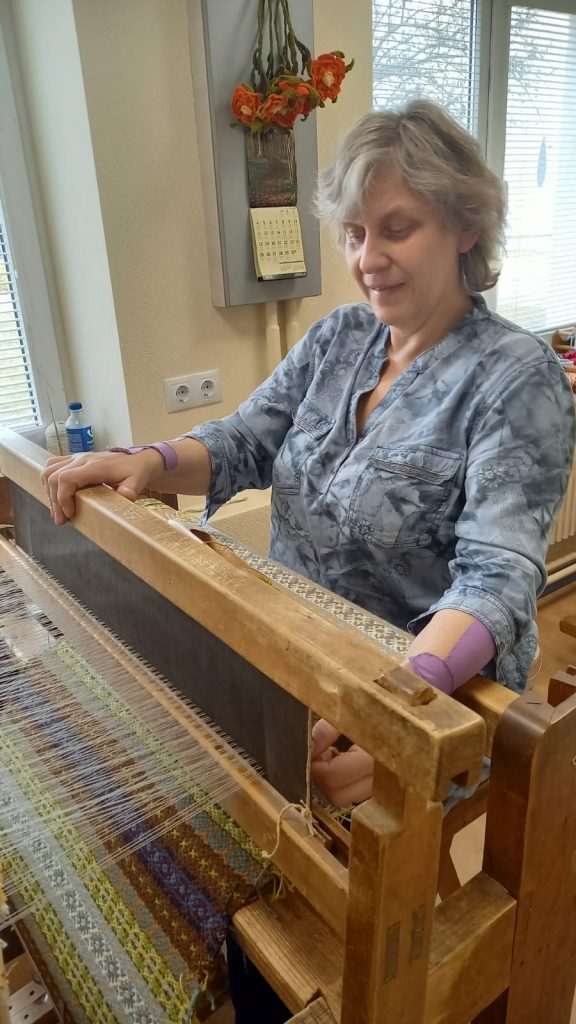Author:
Lila Steinberg
Traditional craft skills
Title
Weaving of belts in Sigulda municipality in a written tissue pulse technique (2022)
Belt blankets, belts, lanes, pine blankets
At the beginning of the 20 th century, the belts were known as the type of ornamental fabric, but relatively complex textiles were used for their weaving. 20 th century. In the 80 s, a simplified technical design was created in the People's applied art studio (hereinafter REFERRED TO AS “Krimulda”) in a written tissue-collar technique using 8-digit rounds, with extensive ornamental facilities.
Geography
Sigulda municipality, Vidzeme, Latvia
Several groups of interested people can be distinguished in the weaving of belts:
• Truth-craftsmen who are prepared to continue the weaving of these Ornamental and colorite blankets. The most active tolls from “Krimulda” and “Sigulda” were the People's daiļamata meistares (hereinafter TDM): Velta Stege, Inta Drozdova, Antoņina Kancāne, Lilly Sica, Erica Weinberg, Helga Baumane, Helen Miller, etc., who are no longer among us, as well as Mars Polane, Anda Larmane, scene wolf, etc., whose active weaving has ended. But with his knowledge and experience in the weaving of the youngsters, he is willing to share the cosarenoka, Lila Steinberg, Guna Zandberg, Dzintra Ginth, Adispute Freimane, Anita Pildegovičs, Rasma Rubene, Irene Balode, Eneri stone, Ludmila Ustinova.
young weavers who want to learn and continue their youngsters' business skills. He is currently conscious of a number of cultural-historical Vidzeme Municipalities: Valmiera (TLM “Mazsalaca”, Rencene weaving group), Gulbenes (TLMS “saga”), Saulkrasti (the “copart of the Saulkrasti weaving set”), Smiltenes (TLMS “Smiltene”, Blomes weaving group), Madona (National School of Sardinia), Sigulda (TLMS “Urga”), Jurmala (Jurmala weaving set), Limbaži (“Staicele”, non-governmental organisation (hereinafter NGO) “9 arodi”), Cēsis (Vault weaving group), whose participants wish to learn the auspices of these unique blankets. The identification of stakeholders continues.
• Users who, in understanding the importance of the Latvian ethnographic ornament, want to obtain such products for use in order to emphasize and preserve their ethnic identity.
• Users who have received a belt in a legacy or gift shall keep them as a certificate of dignity and admiration for the masterness of previous generations (including museums).
Importance in Community Life
The woven fabric of the patterned tissue is wide-ranging and can be used for ornamental purposes such as wall blankets, floor coverings, furniture fabrics, curtains, blankets and clothing fabric. The most important thing that the creation of decorative, modern-day textiles is the use of ancient belt rotation traditions and compositions. The lumbar blankets reflect the beauty of the beauty of the Latvian people and many centuries combined with technical mastery. Depending on the colour of the fabric, the weaving experience and the patience, the operation obtains a large geometric and colorite Ornamental diversity.
As a result of the publication in the magazine “woman” (February 1994, author V. Stege) and the training of businessmen of applied art studies at the Latvian National Cultural Centre (hereinafter LNKC), the musical weaving skills had been acquired by many wedding in Latvia, but the intense work of these decorative blankets took place IN TLM “Krimulda” and THE TLEM “Sigulda”. The interviewers of the weaving team have shown that there is little to be left in Latvia, most of which are representatives of the older generation, mainly in Sigulda District. Therefore, currently, the belt blankets are not actively made. However, the new generation of generations has an interest in the process of weaving the belts, the willingness to learn it, thereby emphasising the modern nature of the Latvian ornament in order not to lose the Latvian People's intangible heritage and identity code.
As a unique value for future generations, the Latvian Etnographic Museum of Latvia has purchased two TLEM “Krimulda” masters' belts (autores – League of League and Lila Šteinberg), while Latvian National History Museum one (author Lila Šteinberg). Many signatures of Sigulda Municipalities are preserved in private collections, both in Latvia and beyond.
Activities/Actions
In the first half of the 20 th century, complex weaving techniques have been used in the first half of the 20 th century, namely the reading of the article with the help of scales, the doubling, the towed device, or the Vilnius stalls with many (10-16 and more) fungi that were labour-intensive. Mutual competition motivated the growers to seek new opportunities to create more orchestrated fabric, but with simpler methods, and in the majority of agricultural holdings there were stubs which could technically be equipped with 2-4-8 nights. New solutions were sought to simplify this process while maintaining Ornamental diversity.
The technical simplification of the weaving process was followed by the use of the patterned tissue pulse technique in 8 ng. This method is analogous to the familiar “royalty” with a 4-nut design and an open point. By doubling the number of cards up to 8 and changing the Pamin volume, the combination of skill parts results in expanded opportunities for the diversity of articles and ornaments.
The written tissue collar is often used in weaving technique for the weaving of cross-lined blankets, where both sides of the equally well-used fabric are equally well used. They are characterised by a slightly ribbed surface with compacted tissue thread, but the volume is reinforced with the opposite parts of the same volume. The tissue density is large, the towel thread is not visible in this fabric and the pattern is made up of tissue threads in different colours. The filaments are taken in at least two colours, one on the surface, the other being the bottom. Therefore, both sides have the same pattern, only paint opposing, which corresponds to the principle of Auleau-type belt weaving.
The weaving of the belts shall be divided into at least three equally important stages.
1. The technical fitting of the fabric base in the stalls where the cotton thread is used and the wool yarn.
2. Combining ornamental bands and designing creative derivation using the volume of the volume. Depending on the order in which it is mentioned, it is possible to create different width and configuration ornamental bands.
3. Before starting the weaving, a colorative solution or color sketch is created. The wool yarn is therefore coloured in different shades using vegetable or chemical colours. When you plan to sketch a colorite sketch, you often use a composition of Vidzeme-stained or shattered blankets, where color shades are organized in fine shifts from lighter to darker or vice versa, creating rapors or parts of a pattern that are symmetrical repeating. The most frequent sources of color compositions are the landscape of Latvia: the blue sky, the rivers and lakes, where the currents and waves fall along the grey stones, the brown sandstone, the flame and oak green, which are reflected in the Gauja waters, the white Ieva flowers in Sigulda, etc.
Inheritance and Transfer
Weaving is currently held both individually and collectively in Latvia. There are separate masters who have set up workshops and professionally work on their products in the market. However, more often is woven in applied art studies or in clusters under the guidance of professionally educated weaving specialists, the weaving stakeholders working together at the hobby level. The main advantage of collective activity is the presence of a competent teacher who helps to address technical or artistic problems, where these arise, thereby encouraging participants to experience theoretical knowledge at the same time and to gain and strengthen practical skills. Currently, the acquisition of weaving skills in Latvia takes place in 67 studies, which are combined WITH LNKC.
The identification, exploration, preservation, and the interest of the new generation in the Latvian ornament and the People's art is necessary:
• practical training of stakeholders,
• organize exhibitions,
• Promote the uniqueness and weaving methodology of this product.
In order to collect THE TLEM “Krimulda” and THE TLEM in the private collections of the Sigulda masters, the exhibition “from the piano trunk” was organised in the new Palace of Sigulda in 2022 from 16 March to 18 April. Jostenburg 'with a continuation in Krimulda's People's House (22.04-23.05 .2022). 17 blankets were offered for the audience rating. More than a thousand viewers visited the exhibition.
History
One of the oldest forms of textiles – woven belts and pine trees – was an integral and often one of the most luxurious ingredients of Latvian clothing, the significance of which has changed in the past centuries. The first strawberries were made in the 19 th century, sewing together many belts and pine trees. They quickly gained a positive assessment of users. But the complexity of the complex business encouraged people to look for other ways to make the result easier.
The idea of the weaving of youngsters in a written tissue-collar technique was the 20 th century in Krimulda. In the 80 s, when the studio member, Mars Polane, showed an inheritance from her mother Ella Enok, a decorative blanket of ornament-lined woven fabrics (see pictures) used in the family as a piano cover. Ella Enok had made this blanket as a mastersticist, or the final work of the tests, graduating from the Kaucmindes Household Seminar (1932). The blanket can be seen as family reluctance, who had spent Ellla all the time in Siberia and returned to Latvia successfully. Perhaps that blanket and articles kept Ella's connection with his homeland, warmed the girl's heart in Siberia's cold, helped to withstand the heavy expedition tests and urged her to return home.
Mara's desire was to continue her mother's work and encourage others to make something like that. After a thorough examination OF the fabric, THE head of “Krimulda”, along with the People's fiction masters, had resolved the fabric of the fabric, and the process of weaving could begin.
The Mara Fruit was so unique that other students were thrilled with excitement in the new challenge. In contrast to the previously made belt blankets, Krimuldas fabric, using fine colour transient yarn threads, belts and pine trees combined into a related, mutually agreed colour rhythm, resulting in a single composition.
The prosperity and the norm of the belts are largely linked to the political economic developments in Latvia.
As of the first half of the 20 th century, the woven belts were mostly used for ornamental purposes, sewing together and making blankets (scene Alsupe. “Weavers in Vidzeme”. Riga: science, 1982)
20 th century. During the 20 th and 30 s, during the First Independence of Latvia, there was a special desire to play a sense of belonging to his ethnic group in the People's art. This facilitated the association of the ruling national romancy with the People's Senior Study, ethnography, Latvian ornament. The most important researchers in the Latvian ornament were the artist Jacob Bine and Ernest Brastiņš. In the book “Latvian Ornamentica” (Riga: Germans, 1923) Ernest Brastiņš calls for awareness of the Latvian ornament as the ethnographic heritage of the past.
In the 80 s, at the end of the Soviet occupation, the representation of Latvian ethnography and ornament in the People's art was a form of ethnic identity and a silent protest against absurd bans of the ruling politics and Soviet propaganda. The “People's Applied Arts Councils in Latvia 1970-1985” (A. Alsupe, A. Cargane, Riga: science, 1988) says “very favourites are traditional belt blankets. In the first half of the 20 th century, they were made by a variety of contrasts, but in our days the fabric is trying to keep the product in one color tonality, make up the thumbnail and select the pattern themes that are subject to a more uniform rhythm. Therefore, the present-belt blankets look more fragile, more foolish, more suitable for small spaces.
In turn, the 20 th century. The 90 s were linked to the national awakening, the restoration of Latvia's independence, the excitement of society. This gave the people a deeper understanding of the ethnography of Latvians and the Ornamental article as the value of the People's Identity. During this time, the yostiners also receive the highest assessment of the society. In 1993, XXI's general Latvian song and XI dance festival art exhibition TLMS “Krimulda” is produced by artist brothers Ernest and Arvīda Brastiņš memorial medal.
The new millennium opened the curtain to the cultural awareness of the European and world peoples who made changes in the Community's life. The leading role was commercialised, the multicultural style came into fashion, minimalism, the denial of the etno style, which facilitated the weaving of the belts.
Today, in the context of current geopolitical events, there is a renewed interest in Latvian identity and culture. Anete Karlsone's book “Character jostas: The Common Cultural Layer” (Riga: LNKC, 2018) updates the possibilities of the weaving of the belts and stresses: "the weaving of belts today is not only the preparation of the items belonging to the peoples. 20 th of the Latvian ethnographic heritage and the 20 th century. In the 20 th, 30 s they became an important reflection of the ornamental richness of cultural heritage. 'It is therefore particularly important to preserve not only the belt, but also the weaving skills of the belts as the value of intangible cultural heritage.
Masters
The masters, in the scraps of the woodstained tissue, in the technique of 8 nations, interrogate: Lila Steinberg, Dzintra Ginth, Guna Zandberg, vija Kosarenoka, Eneri stone, Ludmila Ustinova, Maria Liniņa (TLMS “Krimulda”), and Anita Pildegovič, Rasma Rubene, Irene Balode, Adispute Freimane, Anda Kalanepa (TLM “Sigulda”).
Institutions and Organizations
Sigulda municipality municipality,
“Krimulda”,
“Sigulda”,
NGO “9Arodi”
Strengthening the Tradition
Several important activities have been performed to preserve and promote the weaving skills of youngsters.
1. Organised seminars and training:
• In 1993, there was a training of the head of the Latvian National Centre for the Authentication of Art in the auspices of the Latvian National Cultural Centre, under the direction of the Latvian National Cultural Centre.
• In 2022, from 8 to 10 April, IN THE event organised BY LNKC, “meet your master!” “TLM“ Krimulda ”and THE TLUM“ Sigulda ”, under the direction of masters, took place in the weaving training.
2. Publications in press, media:
• Stege, V. Jostinblankets, woman, 1994, No. 2;
dexne, Inherited beauty, practical Latvian, 2009, No. 23;
dexne, D. Jostinblankets, practical handworks, 2021, No 6;
• Latvian blankets for Latvia's thousand years. Riga: Sana Solaris, 2018, 574 pp. (published by a number of Latvian pearl-craftsmen's handkerchiefs).
3. Blankets exhibited at various exhibitions:
• 1990 - Exhibition of XX general Latvian songs and X dance festivals;
1993 - Festival of THE XXI general Latvian song and XI dance festival;
• 1994 - Riga City Exhibition;
2002 - “Krimulda” exhibition in Krimuldas civil parish in Krimulda parish;
2003 - Festival of THE XXII general Latvian song and XII dance festival;
2008 - 2008 - XXIV International Festival of Latvian Song and XIV Dance Celebration;
2009 - “Krimulda” exhibition in Krimuldas civil parish in Krimulda parish;
2009 - exhibition “belts, belts, bands” at the Latvian Etnography Museum;
2016 - “Latvian District cover” of the Republic of Latvia exhibition in Kuldīga;
April 2022 - exhibition “from the piano trunk.” Lumbar blankets in the new palace of Sigulda;
_ _ _ _ _ _ _ _ _ _ _ _ _ _ _ _ _ _ _ _ _ _ _ _ _ _ _ _ _ _ _ _ _ _ _ _ _ _ _ _ _ _ _ _ _ _ _ _ _ _ _ “Shostenburg” in Krimulda's People's House.
In the Vidzeme region (with THE “Krimulda” initiative), there are identified stakeholders who would like to learn the wedding skills in the coming years by gradually involving other TLEM and weaving masters in the training process.
The best way to periodically demonstrate the performance of amateurs and the interest of the public is the organisation of exhibitions.
These exhibitions were widely attended by both Latvian and foreign viewers, and, undeniably, there was respect and admiration of our masters' achievements. Often after the exhibitions, THERE were new participants who wanted to learn the skills of weaving and knowledge of the People's art, as well as stakeholders who wanted to buy their own unique blankets.
Thanks to the publicity methodology published in local press publications, the information was collected by the wealthy who tried the process themselves.
In 1993, THE “Krimulda” collective, thanks to the gorgeous bells, XXI's overall Latvian song and XI dance festival at the People's applied art exhibition, gained a high rating – the artist brothers Ernest and the Arvīda Brastiņš memorial medal.
The largest support and assistance to the development and preservation of the weaving skills of the youngsters has been invested by the country: the Latvian National Cultural Centre, by co-ordinating the activities of the weaving group and the People's applied art collective, organising various textile exhibitions and partly financing (a grant is granted to motivate the artistic collective managers) IN THE activities of THE TLMS managers, as well as Sigulda Municipality, which financially supports THE TLEM “Krimulda”, THE TLMS “Sigulda”, THE TLMS “vigrieze”, THE TLMS “Urga”, providing the premises, the necessary technologies and the attraction of competent teachers. In 2022, from 16 March to 22 May, the cultural centre of Sigulda in Sigulda's new palace and from 18 April to 22 May in Krimulda's People's House organized an exhibition of Jostinblankets “from the piano trunk. Belt blankets, where 17 private collections were exposed. Media involvement is also particularly important, namely“ practical handicaps ”on 6 October 2021 published a methodology for the weaving of belts, which encouraged interest in the use of this weaving technique.
In the following five years, see the annexes for the development of planned yowel weaving skills.
Continuity/Development
IN collaboration with weaving masters from other Vidzeme (NGO “9Arodi”) and Sigulda municipality, TLMS “Krimulda” will conduct research in the Latvian ethnographic artistic museum, the Latvian National History Museum, as well as other Latvian city history and applied art museum funds, with the aim of clarifying the history of the development of the belt, alternative weaving methods and traditions in Latvia and beyond, the results being documented and produced by methodological material.
In order to preserve, protect, inherit and promote the weaving skills of youngsters, measures will be taken in four main directions.
1. Training of participants in weaving studies in masters classes.
STUDENTS of “Krimulda” will regularly organise masters and seminars with the aim of attracting new weavers. So far, the interest in the weaving of youngsters has been seen from 11 studies in Vidzeme, but their awareness continues. There is a change of generations in the people's applied art studies and it is particularly important for young actors to learn about ethnographic ornaments and the possibilities of integrating it into fabric.
2. Evaluation of the work of the training.
IN 2027, TLMS “Krimulda” participates with Sigulda Municipality and other studies (in collaboration with LNKC) in 2027.
3. Education of society, especially children and young people, in accordance with the values of the Latvian People's Art, helping to understand ethnographic ornaments and Latvian colour composites.
THE TLEM “Krimulda” in the annual event “meet your mastar!” will present the use of the written tissue rape technique in the manufacture of woven products.
THE PARTICIPANTS of “Krimulda”, together with Sigulda municipality, will provide pre-school educational institutions and students of art schools with information regarding the ethnographic ornament of the Latvian People's Republic, its use in social life.
4. The promotion of the Latvian identity code as a Latvian identity code in Sigulda municipality, in collaboration with the Sigulda District Tourism Information Centre and local government support, is planned to form a special Souvenir line, dedicated to the themes of the belts, belts and the Latvian ornament.
The objectives of the above measures are:
• to promote the increase in the number of berth-entrants;
the promotion of the Latvian People's ethnographic ornament in Latvia and beyond its borders;
• to raise the dignity and awareness of young people about the cultural values of Latvia;
• Updating today's ethnic and national self-awareness as a response to the challenges of globalisation.
Threats to the Tradition
There are several threats to the weaving of the belts in Latvia.
1. Lack of weaving masters. In the middle of the weaving masters there is an ageing population, there are few young people who are interested in the acquisition of these skills. Globalisation, digitisation and commercialisation have changed the values, lifestyles and priorities of society. As a result, in order to ensure stable income with greater profit opportunities, young people in the professional field are choosing profitable industries. While there is a wide range of alternatives for leisure time, the number of people's art enthusiasts is reduced.
2. Product precision:
expensive earthworms with 8-bit layers and equipment to ensure the process;
expensive material – a cotton thread is required for tugs and a variety of coloured wool yarn tissues (the sum of the purchase of one belt may vary from 50 to 100 euro);
time spent in weaving – these blankets are exclusive, usually made in one copy, the work may take two weeks to a month.
3. Low demand in the market. This is explained by the current consumer culture in society, when purchasers select cheaper, more often interchangeable, mass-produced goods, which in turn make up less demand and reduce sales in the market. By increasing the supply of belts and promoting them as Sigulda municipality, Vidzeme's characteristic heritage value is the hope of changing the visibility of the belts and thus the demand.
Applicant
Sigulda municipality municipality, tail No. 90000048152, TLEM “Krimulda”, TLEM “Sigulda”
Gallery
Audio Materials
Video Materials
Text materials
Publications
Dex, D. (2021, No. 6, p. 6,7) belt blankets, “practical handrails”
Steam, V. (1994, No. 2, Annex) Jostenburg, “woman”
Dexne, D. (2009, No. 23) inherited beauty, “practical Latvian”
Websites
“Come on your masters!” calls for the weaving skills; by 17 April, an exhibition of youngsters - interview with the exhibition “from the piano trunk.” In the new Castle of Sigulda (16.03 –18.04 .2022), rīkotājiem from Sigulda Cultural Centre – Lila Stainberg and League of League

